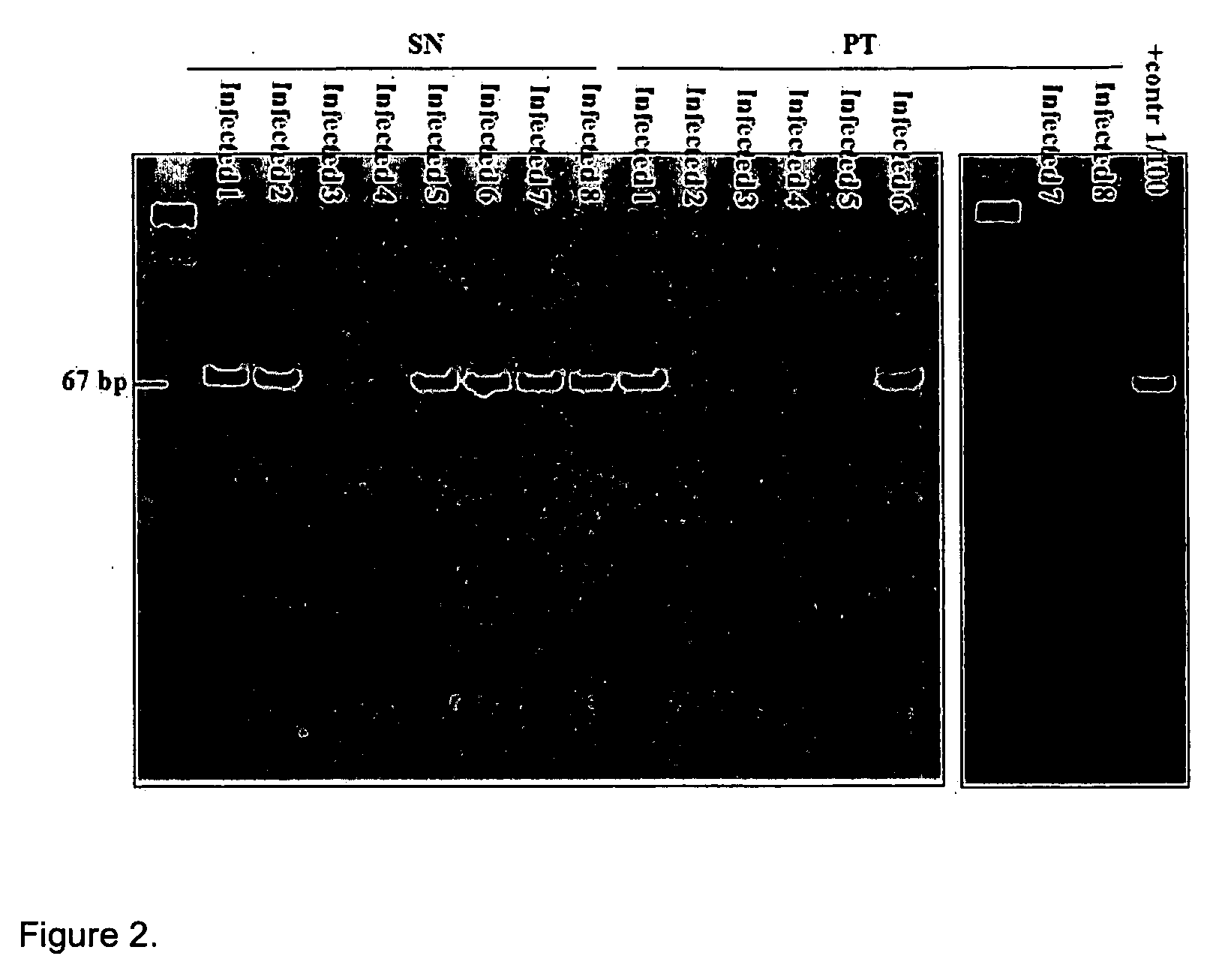Method for diagnosis and monitoring of pathogenic infection by analysis of pathogenic transrenal nucleic acids in urine
- Summary
- Abstract
- Description
- Claims
- Application Information
AI Technical Summary
Benefits of technology
Problems solved by technology
Method used
Image
Examples
example 1
Stabilization and Preparation of the Samples
[0060] The first step in this method is the preparation of the DNA present in the urine sample. This method was described previously in studies of the detection of transrenal DNA in urine. All of the preparation takes place at room temperature (on the order of 24° C.). [0061] A quantity consisting of approximately 50 to 60 ml of urine is collected from the patient in sterile containers. [0062] Within 30 minutes after collection of the urine, 0.5M EDTA and 0.5M Tris-HCl (at a pH of 8.5) are added until a final concentration of 10 mM is reached. The purpose is to inhibit possible nuclease enzymes. Specifically, the EDTA is added to inhibit nucleases that are dependent on divalent ions, and the Tris-HCl is added so that a pH value can be reached that inhibits acid nucleases. This stabilizes the specimen, in the sense that it stabilizes the DNA fragments. [0063] The samples are then divided into aliquot portions of 5 ml and stored at a temper...
example 2
Isolation and Purification of the Nucleic Acids
[0064] Because the idea is to analyze DNA fragments whose length is less than 1000 nucleotides, and preferably less than 500, and more preferably less than 300, and yet more preferably less than 200, and even yet more preferably between 100 and 200 nucleotides, the commercially available DNA isolation kits cannot be used, because they are based on the isolation of DNA having a higher molecular weight.
All of the steps in the following method take place at room temperature (20 to 25° C.). As mentioned above, the sample may consist of aliquot parts of urine, or else of the urine supernatant or of the sediment.
[0065] 2 volumes of GITC [guanidine isothiocyanate] (at a concentration of 6M) were added to 1 volume consisting of 5 ml of sample and mixed well. [0066] The DNA whose length is less than 1000 base pairs of nucleic acids, and preferably less than 500, and more preferably less than 300, and yet more preferably less than 200, and ev...
example 3
Preparation for PCR
The PCR primers are usually constructed for amplicons measuring 60 to 120 nt or 250 to 400 nt. In this case, it was necessary to find primers that could also function for sequences consisting of 150 to 250 nt.
The FastPCR method (biocenter.helsinki.fi / bi / bare-1_html / oligos.htm) was used to design the primer sequences based on the complete human genome sequence.
[0067] The Primer 3 method (frodo.wi.mit.edu / cgi-bin / primer3 / primer3_www.cgi) was utilized to select the nested (semi-nested) primer.
[0068] This method was used to create tuberculosis primers. The primer that was constructed for tuberculosis was reciprocal to the sequence IS 6110, which is present only in the Mycobacterium tuberculosis genome, as indicated below:
IDN 1 F-785: ACCAGCACCTAACCGGCTGTGG(SEQ ID NO:1)andIDN 2 R-913: CATCGTGGAAGCGACCCGCCAG.(SEQ ID NO:2)(Product: 129 nt)
[0069] Instead, for the nested primer, the following sequence was selected:
IDN 1 F-785: ACCAGCACCTAACCGGCTGTGG(SEQ ID NO:1)a...
PUM
| Property | Measurement | Unit |
|---|---|---|
| Length | aaaaa | aaaaa |
| Affinity | aaaaa | aaaaa |
| Degradation properties | aaaaa | aaaaa |
Abstract
Description
Claims
Application Information
 Login to View More
Login to View More - R&D
- Intellectual Property
- Life Sciences
- Materials
- Tech Scout
- Unparalleled Data Quality
- Higher Quality Content
- 60% Fewer Hallucinations
Browse by: Latest US Patents, China's latest patents, Technical Efficacy Thesaurus, Application Domain, Technology Topic, Popular Technical Reports.
© 2025 PatSnap. All rights reserved.Legal|Privacy policy|Modern Slavery Act Transparency Statement|Sitemap|About US| Contact US: help@patsnap.com


